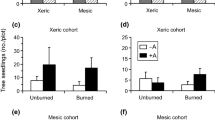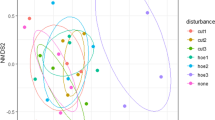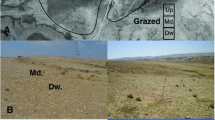Abstract
Our objective was to evaluate effects of disturbance size and soil texture on the development of microtopography for a shortgrass plant community in north central Colorado USA. Disturbances, defined as the death of individual plants, were created in 1984 and 1985 to evaluate development through time of the small-scale pattern of perennial bunchgrasses and bare soil openings that characterize this semiarid grassland. Disturbed plots of three sizes (50, 100, 150 cm-diameter) comparable in size to naturally-occurring disturbances were produced by killing plants at two sites differing in soil texture (sandy loam, clay loam). Disturbed plots were not manipulated after being created. In 1993, a laser surveying instrument was used to measure heights of crowns of individual plants of the dominant species, the perennial bunchgrass Bouteloua gracilis ([H.B.K.] Lag. ex Griffiths), and bare soil openings between plants for two locations: within each disturbance and in the surrounding undisturbed landscape.
Differences between crown heights of plants and bare soil openings were comparable for both the undisturbed landscape and inside disturbances indicating that small-scale microtopography had recovered within nine years after disturbance occurred. However, complete recovery to the undisturbed state had not occurred since crown heights of plants relative to bare soil openings were significantly less on disturbed than undisturbed locations. Differences in height between plant crowns and bare soil openings on disturbed plots increased as disturbance size increased, indicating greater soil redistribution with increasing plot size. Larger differences in height were also found on plots on the fine- than the coarse-textured soil, indicating the importance of soil particle size and plant cover type to the development of microtopography. Differences in height between microsites on disturbed plots were positively related to total plant cover and negatively related to cover of B. gracilis indicating the importance of this species to reducing erosion on disturbed areas.
In this semiarid grassland, patterns in microtopography were heterogeneous, likely as a result of the small-scale redistribution of soil between bare soil openings and B. gracilis plants through time. Our results indicate that this redistribution of soil is affected by disturbance size, soil texture, and patchy plant cover. The major effect of small-scale disturbances on patterns in microtopography of the shortgrass steppe are causing plant death and exposing soil to erosional and depositional processes.
Similar content being viewed by others
References
Aguilar M, Kelly E F and Heil R D 1988 Effects of cultivation on soils in Northern Great Plains Rangeland. Soil Sci. Soc. Am. 52, 1081–1085.
Aguilera M O and Lauenroth W K 1993 Neighborhood interactions in a natural population of the perennial bunchgrass Bouteloua gracilis. Oecologia 94, 595–602.
Albertson F A and Weaver J E 1944a Effects of drought, dust, and intensity of grazing on cover and yield of short-grass pastures. Ecol. Monogr. 14, 1–29.
Albertson F A and Weaver J E 1944b Nature and degree of recovery of grassland from the Great Drought. Ecol. Monogr. 14, 394– 479.
Archer S, Garrett M G and Detling J K 1987 Rates of vegetation change associated with prairie dog (Cynomys ludovicianus) grazing in North American mixed-grass prairie. Vegetatio 72, 159–166.
Belsky AJ 1986a Revegetation of artifcial disturbances in grasslands of the Serengeti National Park, Tanzania. I.-Colonization of grazed and ungrazed plots. J. Ecol. 74, 419–437.
Belsky A J 1986b Revegetation of artificial disturbances in grasslands of the Serengeti National Park, Tanzania. II.-Five years of successional change. J. Ecol. 74, 937–951.
Bormann F H and Likens G E 1979 Pattern and Process in a Forested Ecosystem. Springer-Verlag, New York. 253 p.
Bolton J, Smith J L and Link S O 1993 Soil microbial biomass and activity of a disturbed and undisturbed shrub-steppe ecosystem. Soil Biol. Biochem. 25, 545–552.
Burke I C 1989 Control of nitrogen mineralization in a sagebrush steppe landscape. Ecology 70, 115–1126.
Burke I C, Lauenroth W K and Coffin D P 1995 Soil organic matter recovery in semiarid grasslands: implications for the Conservation Reserve Program. Ecol. Appl. 5, 793–801.
Coffin D P and Lauenroth WK 1988 The effects of disturbance size and frequency on a shortgrass plant community. Ecology 69, 1609–1617.
Coffin D P and Lauenroth W K 1989a Small scale disturbances and successional dynamics in a shortgrass plant community: interactions of disturbance characteristics. Phytologia 67, 258– 286.
Coffin DP and Lauenroth WK 1989b Spatial and temporal variation in the seed bank of a semiarid grassland. Am. J. Bot. 76, 53–58.
Coffin D P and Lauenroth W K 1991 Effects of competition on spatial distribution of roots of blue grama. J. Range Manage. 44, 68–71.
Coffin D P and Lauenroth W K 1992 Spatial variability in seed production of the perennial bunchgrass Bouteloua gracilis (Gramineae). Am. J. Bot. 79, 347–353.
Coffin D P and Lauenroth W K 1994 Successional dynamics of a semiarid grassland: effects of soil texture and disturbance size. Vegetatio 110, 67–82.
Coffin D P, Lauenroth WK and Burke I C 1993 Spatial dynamics in recovery of shortgrass steppe ecosystems. Lect. Math. Life Sci. 23, 75–108.
Coffin D P, Lauenroth W K and Burke I C 1996 Recovery of vegetation in a semiarid grassland 53 years after disturbance. Ecol. Appl. 6, 538–555.
Gillette D A 1977 Fine particulate emissions due to wind erosion. Trans. Am. Soc. Agric. Eng. 20, 890–897.
Gillette D A and Walker T A 1977 Characteristics of airborne particles produced by wind erosion of sandy soil, high plains of Texas. Soil Sci. Soc. Am. J. 123, 97–110.
Hobbs R J and Mooney H A 1985 Community and population dynamics of serpentine grassland annuals in relation to gopher disturbance. Oecologia 67, 342–351.
Hobbs R J and Mooney H A 1991 Effects of rainfall variability and gopher disturbance on serpentine annual grassland dynamics. Ecology 72, 59–68.
Hook P B, Burke I C and Lauenroth W K 1991 Heterogeneity of soil and plant N and C associated with individual plants and openings in North American shortgrass steppe. Plant Soil 138, 247–256.
Hook P B, Lauenroth W K and Burke I C 1994 Spatial patterns of roots in a semiarid grassland: abundance of canopy openings and regeneration gaps. J. Ecol. 82, 1–10.
Kelly R H and Burke I C 1997 Heterogeneity of soil organic matter following death of individual plants in shortgrass steppe. Ecology (In press).
Lauenroth W K, Sala O E, Coffin D P and Kirchner T B 1994 The importance of soil water in the recruitment of Bouteloua gracilis in the shortgrass steppe. Ecol. Appl. 4, 741–749.
Lee C A and Lauenroth WK 1994 Spatial distributions of grass and shrub root systems in the shortgrass steppe. Am. Midl. Nat. 132, 117–123.
McClave J T and Dietrich F H II 1988 Statistics. Dellen Publishing Company, San Francisco, CA.
Milchunas D G, Lauenroth W K, Chapman P L and Kazempour M K 1989 Effects of grazing, topography, and precipitation on the structure of a semiarid grassland. Vegetatio 80, 11–23.
Peart D R 1989 Species interactions in a successional grassland. III. Effects of canopy gaps, gopher mounds, and grazing on colonization. J. Ecol. 77, 267–289.
Pickett S T A and White P S 1985 The ecology of natural disturbance and patch dynamics. Academic Press, San Diego, CA.
Sala O E, Parton W J, Joyce L A and Lauenroth W K 1988 Primary production of the central grassland region of the United States. Ecology 69, 40–45.
SAS Institute Inc 1988 General linear Model Procedure (PROC GLM). SAS, Madison, WI.
Schlesinger W H, Reynolds J F, Cunningham G L, Huenneke L F, Jarrel W M, Virginia R A and Whitford W G 1990 Biological feedbacks in global desertification. Science 247, 1043–1047.
Sousa W P 1984 The role of disturbance in natural communities. Annu. Rev. Ecol. Syst. 15, 353–391.
Stephens G and Whitford W G 1993 Responses of Bouteloua eriopoda to irrigation and nitrogen fertilization in a Chihuahuan desert grassland. J. Arid Environ. 24, 415–421.
The Great Plains Flora Association 1986 Flora of the Great Plains. University Press of Kansas, Lawrence, KA.
Vinton MA and Burke IC 1995 Interactions between individual plant species and soil nutrient status in shortgrass-steppe. Ecology 76, 1116–1133.
White P S 1979 Pattern, process, and natural disturbance in vegetation. Bot. Rev. 45, 229–299.
Yonker C M, Schimel D S, Paroussis E and Heil R D 1988 Patterns of organic carbon accumulation in a semiarid shortgrass steppe, Colorado. Soil Sci. Soc. Am. J. 52, 478–483.
Zobeck T M and Fryrear D W 1986 Chemical and physical characteristics of windblown sediment. I. Quantities and physical characteristics. Trans. Am. Soc. Agric. Eng. 29, 1032–1036.
Author information
Authors and Affiliations
Rights and permissions
About this article
Cite this article
Martinez-Turanzas, G.A., Coffin, D.P. & Burke, I.C. Development of microtopography in a semi-arid grassland: Effects of disturbance size and soil texture. Plant and Soil 191, 163–171 (1997). https://doi.org/10.1023/A:1004286605052
Issue Date:
DOI: https://doi.org/10.1023/A:1004286605052




